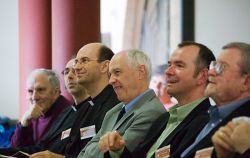The Fifth International Liturgical Conference
At the end of May and beginning of June the Fifth International Liturgical Conference was held in Bose. Continuing the reflections on the relation between liturgy and architecture begun at earlier conferences, it treated the topic of “baptistery” and, more in general, of the places where baptism and penance take place.
The conference was promoted by our community in collaboration with the National Office for Church Cultural Properties of the Italian Bishops’ Conference, which was represented by its director, don Stefano Russo. Architects, liturgists, theologians, artists, persons responsible for cultural properties of the Church took part, as well as many other persons interested in these topics. The presence of André Lossky of the St Serge Institute in Paris as delegate of the ecumenical patriarchate of Constantinople and of father Konstantinos Karaisaridis as delegate of the Holy Synod of the Church of Greece provided an ecumenical dimension to the conference. In his talk at the opening of the conference, our prior Enzo noted that the baptistery is in a certain way a topic of greater relevance and urgency than others, because of the rise and growing diffusion of the catechumenate of adults in many European countries. He also stressed that, “if other elements of liturgical architecture, such as the altar, the ambo, and the orientation of space are pregnant with significance especially ad intra, the baptistery draws us to reflect particularly on the value of liturgical space ad extra, before the world… The baptistery, in a special way, because it stands a little in front of the church, as if in anticipation of it, is its outermost point, the point most inclined towards mankind, thus in its style, in its dimensions as in its forms, it attests that, in what concerns the Gospel, the way of announcing it is already itself Gospel.” Of the speakers we wish to mention with gratitude father Frédéric Debuyst, Paul De Clerck, Anne Da Rocha-Carneiro, Giuliano Zanchi, Albert Gerhards, Maria Schwartz (widow of the great German architect Rudolf Schwartz), Enrico Mazza, father Robert Taft, and father Philippe Markiewicz, author of a recent book on the topic of liturgical architecture.
